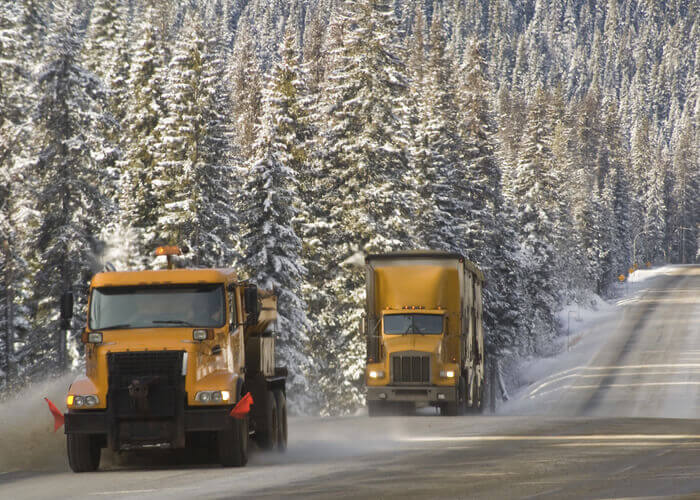Being a trucker means you have to be on point when driving in hazardous weather. You have more weight to control, and less room to control it in. A combination of common sense, experience and keeping your cool will help you go a long way without problems. We thought we would get a bit more specific than that.
Good habits to keep yourself safe in winter weather
Keep a list of reliable weather broadcasters. Use more than one medium if possible – your stereo, NOAA weather, smartphone apps from the Weather Channel and the old standby, the CB radio. It’s a good idea to check on updates once an hour, more if you can see questionable conditions looming ahead.
Always perform a pre-trip inspection
A pre-trip inspection is even more important in the winter. Inspect your headlights and safety lights for excess road grime. In winter, this collects more readily on your truck surface. Drain air from both the truck’s tanks and the trailer’s. Condensation in the air lines is the #1 cause of frozen brakes. Be extremely cautious about pulling to the shoulder when you blow a tire. Snow conceals uneven terrain and soft soil that can be dangerous to you and your truck.
Do more inspections en route
Bad weather breaks down equipment piece by piece. Do NOT assume that just because your semi truck is running that it will continue that way. Things can happen in an instant. Do not forget to stop after going through a patch of bad weather to knock the snow and ice off the mud flaps, ICC bumper, chain hangers, etc. These are a hazard to your rig, and they are absolutely a hazard to car commuters.
In bad weather, calculate your speed at 25mph, even though you may be able to make better time than that. If you overestimate your speed you may run out of your driving hours or hit your 14 before you can get to a safe place. Remember that the extra two hours of driving for unforeseen traffic or weather only applies if the weather came on so fast that weather services weren’t able to broadcast it. That doesn’t happen often.
If your truck gives even the slightest sign of running harsh or breaking down during hazardous weather, do not try and keep it on the road. Exit to the nearest service facility and perform a thorough inspection of all equipment. It may take a few minutes to do this, but spotting a problem early can save you hours of trouble later. If you break down in harsh weather, many times a tow tractor will NOT come to get you until it clears up.
What to bring with you:
- Chains
- Bungees
- Cam Lock T-handles
- Waterproof gloves
- Reflective vest
- Flashlight
- Kneeling pad
- Heavy duty boots
- Double up on warm clothing like hats, gloves and neck protection
- Extra warm bedding
- Extra Washer Fluid
- Anti-gel
The off months
It may be a good idea during the warmer days of spring and summer to take notes on where the chain up and chain off places are, and making an alternate list for parking spots. It’ll come in handy if there’s ever a REAL emergency due to weather conditions.
